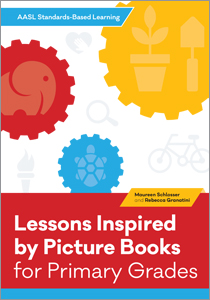Interview: Maureen Schlosser and Rebecca Granatini on AASL Standards–based learning for primary grades
The first book to be published in the AASL Standards–Based Learning series, Lessons Inspired by Picture Books for Primary Grades is a ready-to-go toolkit that aims to build learner competencies. Included are anchor chart examples that explore collaborative practices, and in fact the writing of the book was a collaboration between a school librarian (Maureen Schlosser) and a curriculum specialist (Rebecca Granatini). In this interview the authors discuss how that collaboration played out, the methods they use to discover quality picture books, and how the AASL Standards apply to primary grade learners.
You both blog at the excellent site Library Lessons. How was your collaboration on this book different, and did you have any happy surprises during the process?
 Maureen Schlosser: Our blog is much different than our book. The blog provides a platform for us to bring attention to compelling books. Our lesson ideas serve as a starting point for readers. They are musings for school librarians to explore and perhaps further develop. We write the blog posts independently because they are not extensive plans with measurable outcomes. The book was much more involved. We began our collaborative efforts when the idea for the book struck us. We understood there was a need for school librarians to have ready-to-go lessons that met the new standards. We heard school librarians say they needed assessments. Rebecca’s background in curriculum work and my experience as a school librarian helped us form detailed lessons, worksheets, assessments, and rubrics that support the AASL Standards Framework for Learners.
Maureen Schlosser: Our blog is much different than our book. The blog provides a platform for us to bring attention to compelling books. Our lesson ideas serve as a starting point for readers. They are musings for school librarians to explore and perhaps further develop. We write the blog posts independently because they are not extensive plans with measurable outcomes. The book was much more involved. We began our collaborative efforts when the idea for the book struck us. We understood there was a need for school librarians to have ready-to-go lessons that met the new standards. We heard school librarians say they needed assessments. Rebecca’s background in curriculum work and my experience as a school librarian helped us form detailed lessons, worksheets, assessments, and rubrics that support the AASL Standards Framework for Learners.
Rebecca Granatini: Our book is really the foundation of how to create a strong collaborative library program that uses the AASL Standards as the core to all learning. Our blog is a way to continually update readers about fabulous new (and often newly found) books that are just perfect to blend within this foundation. Maureen is an incredible book curator. She can always find that perfect connection. I have so much fun using her knowledge to support all of the curricular areas! The biggest surprise was just how connected the AASL Standards are to all 21st Century skills and all other curriculum. As a curriculum specialist, I believe that the AASL Standards are among the most forward thinking standards that exist right now! I am proud to be part of this collaborative work.
You draw on picture books in order to explore “big ideas.” What was your selection process like?
Maureen Schlosser: When we find a book that makes our brains pop with wonder and possibilities, we know we’ve got a compelling book to introduce a lesson. To find those books, we read monthly journals and follow social media feeds about children’s literature. We visit our public libraries to read books on our radar and purchase the books we love. The Connecticut public libraries do an incredible job of stocking their shelves with new literature.
 Rebecca Granatini: In addition to what Maureen mentioned, I would add that word of mouth is helpful as well! There is nothing better than being part of a collaborative conversation when you learn about that “just perfect” book that will engage readers as they develop their understanding through the Standards.
Rebecca Granatini: In addition to what Maureen mentioned, I would add that word of mouth is helpful as well! There is nothing better than being part of a collaborative conversation when you learn about that “just perfect” book that will engage readers as they develop their understanding through the Standards.
Inclusiveness and respect for diversity are two big ideas that are part of the lessons in your book. Can you offer some quick tips educators can use to foster discussions with learners about these ideas?
Maureen Schlosser: Start with a compelling picture book. Give learners a chance to notice and wonder. Model what a discussion looks like. Give plenty of opportunities to practice respectful conversations. Post anchor charts around the room for reference. Our book offers anchor charts and worksheets that guide learners in this work. There are two professional books I highly recommend to facilitate meaningful conversations, Teaching Talk: A Practical Guide to Fostering Student Thinking and Conversation by Kara Pranikoff and Reading Picture Books with Children: How to Shake Up Storytime and Get Kids Talking about What They See by Megan Dowd Lambert.
Rebecca Granatini: Beyond the amazing resources that Maureen mentioned, I think it is always important to have shared norms with learners about how they will participate in this type of conversation. This ensures that learners will feel safe, and therefore will be more willing to participate. My other piece of advice is to encourage inquiry. When inquiry is developed organically, we allow space for learners to create their own understandings rather than relying on the opinions of the adults around them. They learn to really think for themselves.
What’s one aspect of the AASL Standards that you each find especially helpful for teaching primary grade students?
Maureen Schlosser: We find the AASL Standards to be a brilliant piece of work. The Competencies propel school librarians to facilitate meaningful lessons that really matter in life. The skills that learners work on are the same skills adults practice every day at work and at home. Take a look at the Shared Foundations: Inquire, Include, Collaborate, Curate, Explore and Engage. They encompass important work habits in successful environments.
Rebecca Granatini: The AASL Standards push learners to gain the skills that are necessary to be responsible and resourceful in the world around them. We want learners to make important decisions for themselves while considering multiple viewpoints, reliable and unreliable sources as well as civic responsibility. It is about so much more than what happens within the walls of a school. It is really about what happens as soon as learners step outside of the school doors, into the world. These standards raise the bar of just how we can prepare our learners for what they will need to be successful in an ever-changing world.
I understand you’ve already gotten some really positive responses to the book! Now that it’s finished, what do you find most gratifying about how the book is actually being used by educators?
Maureen Schlosser: Our favorite lessons in the book are the lessons we actually did together at Colchester Elementary School in Connecticut. It’s exciting to think that the lessons we had so much fun with will happen in other schools. We also hope the book will inspire more collaborative work.  Rebecca created a Crosswalk Guide that shows how working with one book and the AASL Standards connects with so many classroom standards. We recommend that school librarians use this guide to demonstrate how working with the school librarian is a brilliant idea!
Rebecca created a Crosswalk Guide that shows how working with one book and the AASL Standards connects with so many classroom standards. We recommend that school librarians use this guide to demonstrate how working with the school librarian is a brilliant idea!
Rebecca Granatini: The feedback that I am most excited about is that of librarians who have shared with me that they took what we presented in the book and ran with it! Maureen and I shared what has worked for us, and shared many extensions for consideration. It is amazing when a librarian writes us to share a new angle on something that we shared. We encourage librarians and educators to use this book to support their work with the standards in the way that best meets their needs! As a curriculum specialist, I am also thrilled when I find out that librarians have successfully collaborated with a classroom teacher to bring new learning to life! You never know, you may end up with even more than a collaborative partner, you may gain a fabulous friend, like I did with Maureen!
Learn more at the ALA Store.
